lock MAZDA 323 1992 Workshop Manual Suplement
[x] Cancel search | Manufacturer: MAZDA, Model Year: 1992, Model line: 323, Model: MAZDA 323 1992Pages: 279, PDF Size: 24.15 MB
Page 6 of 279
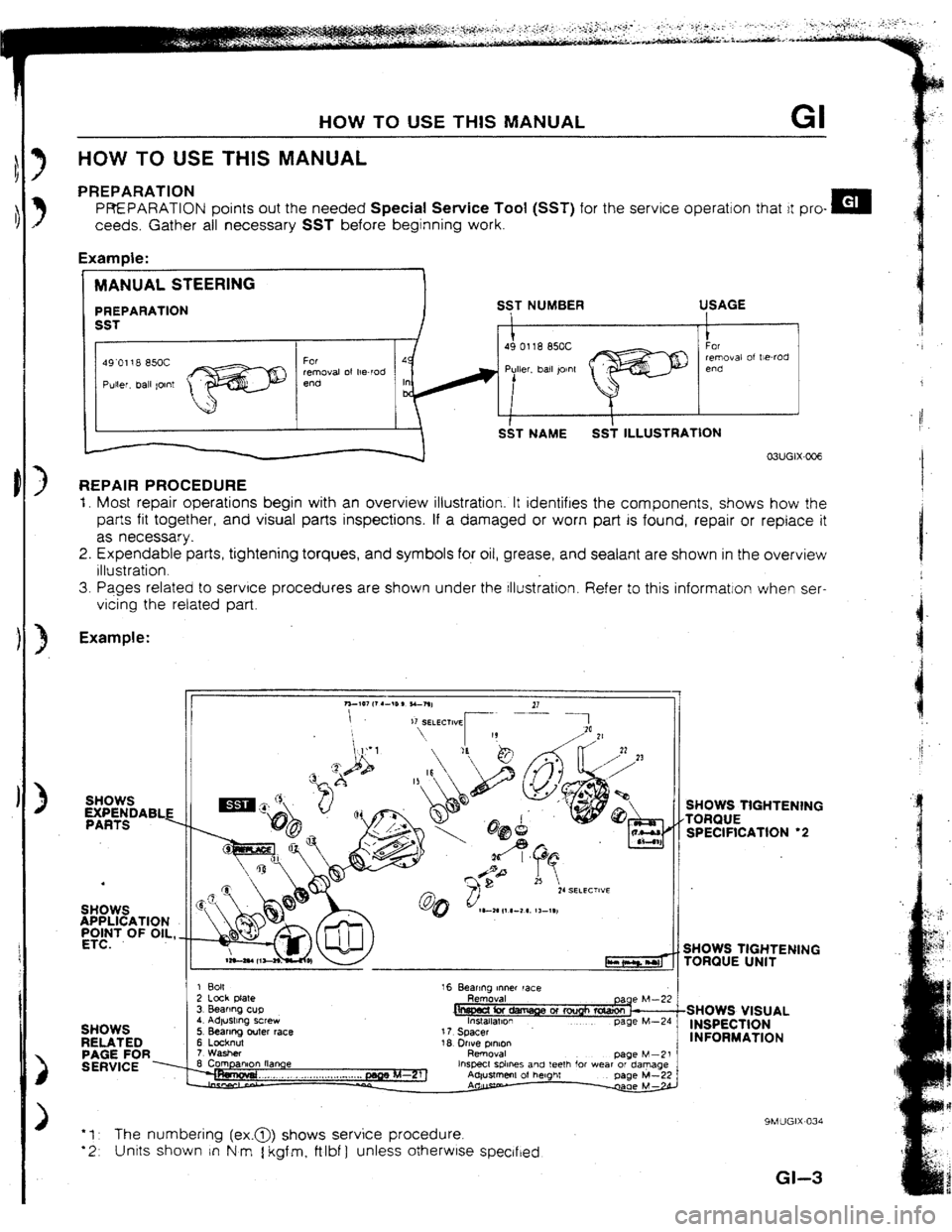
3
3
,
>
1.
3
>
>
HOW TO USE THIS MANUAL GI
HOW TO USE THIS MANUAL
PREPARATION
PREPARATION points out the needed Special Service Tool (SST) for the service operation that it pro- m
ceeds. Gather all necessary SST before beginning work.
Examde:
MANUAL STEERING
PREPARATlON
SST
49’0118 85oC
Puller, ball tolnt For
removal of he-rod
end SST NUMBER
1
49 0118 85oC USAGE
1
For
removal of Wrod
end
S&T NAME SS; ILLUSTRATlON
REPAIR PROCEDURE
I. Most repair operations begin with an overview illustration. It identifies the components, shows how the
parts fit together, and visual parts inspections. If a damaged or worn part is found, repair or replace it
as necessary.
2. Expendable parts, tightening torques, and symbols for oil, grease, and sealant are shown in the overview
illustration.
3. Pages related to service procedures are shown under the tllustration. Refer to this informatron when ser-
vicing the related part
Example:
SHOWS
yA;ytDABLE
.
SHOWS
APPLICATION
;v’dT OF OlL, _
SH
RE
2
3ws .ATED
3E FOR
?VICE . 1 Bolt
2 Lock Nate
3 Bearmg cup
4 Adtustmg screw
5 Bearing outer race
6 Locknut
7 Washer 16 Beanno Inner race
Rem&al
17 Spacer page M-24
18 lhve olnion
Daoe M-21
hspect sphes and teeIh for wear ordaqge SHOWS TIGHTENING
TORQUE
SPECIFICATION
l 2
SHOWS TIGHTENING
TORQUE UNIT
:
SHOWS VISUAL
INSPECTION
INFORMATION
9MlJGIX~034
*I The numbering (ex.@> shows service procedure.
l 2 Unrts shown in N m 1 kgf m, ftlbf ] unless otherwlse speclfted
Gl-3
Page 8 of 279
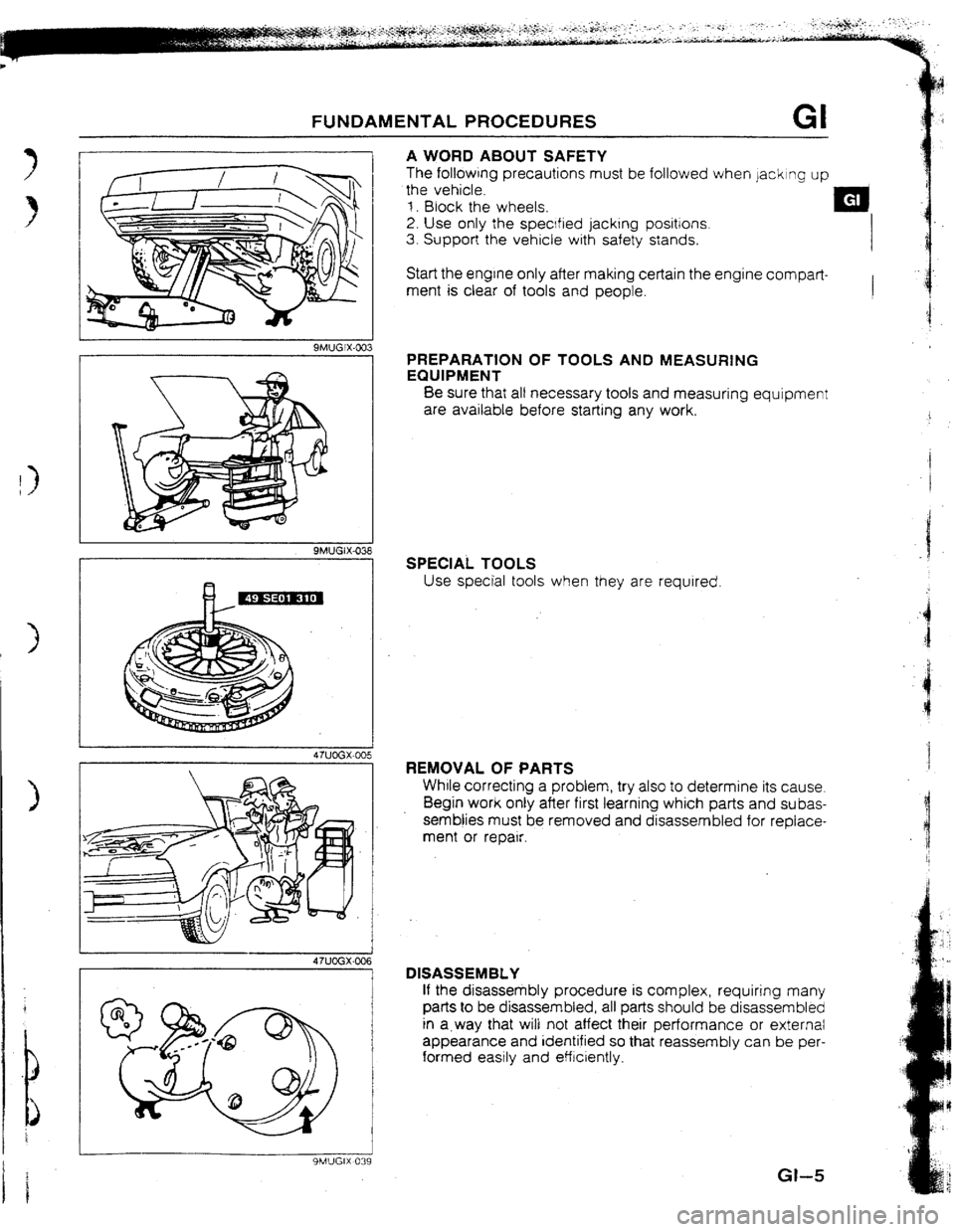
FUNDAMENTAL PROCEDURES GI
A WORD ABOUT SAFETY
The following precautions must be followed when jacking up
the vehicle.
t . Block the wheels.
2. Use only the specfred jacking positions.
3. Support the vehicle with safety stands.
Start the engine only after making certain the engine compart-
ment is clear of tools and people. j
9MUGtX-003 PREPARATION OF TOOLS AND MEASURING
EQUIPMENT
8e sure that al! necessary toois and measuring equipment
are available before starting any work.
SPECIAL TOOLS
Use special tools when they are required.
47UOGX-Cm I 1 REMOVAL OF PARTS
While correcting a problem, try also to determine its cause
Begin work only after first learning which parts and subas-
semblies must be removed and disassembled for replace-
ment or repair. >
DISASSEMBLY
If the disassembly procedure is complex, requiring many
parts to be disassembled, all parts should be disassembled
in a.way that wiii not affect their performance or external
appearance and identified so that reassembly can be per-
formed easily and efficiently. I J
9MUGIX 039
a-5
I 1
Page 9 of 279
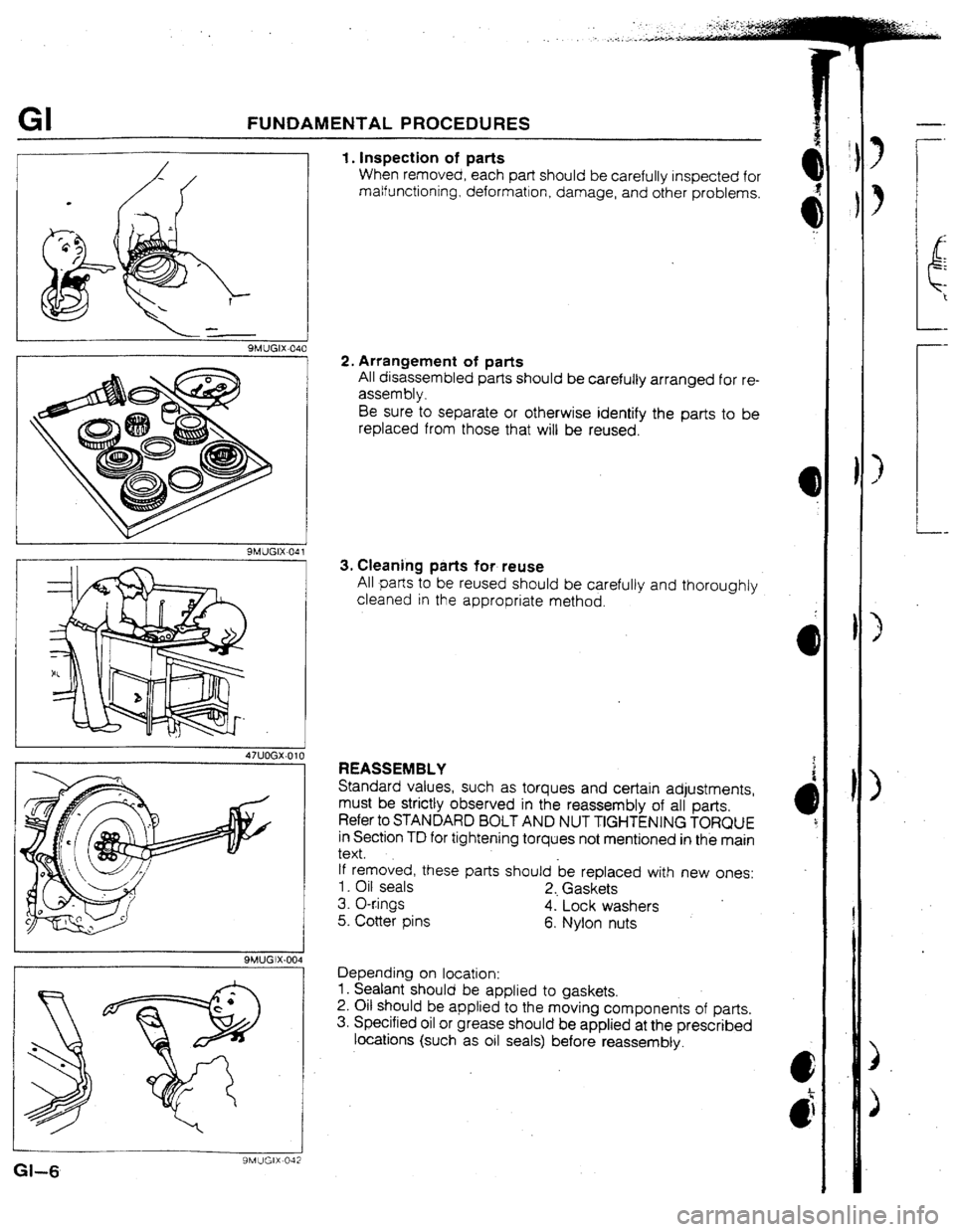
GI FUNDAMENTAL PROCEDURES
I. Inspection of parts
When removed, each part should be carefully inspected for
malfunctioning, deformation, damage, and other problems.
2. Arrangement of parts
All disassembled parts should be carefully
arranged for re-
assembly.
Be sure to separate or otherwise identify the parts to be
replaced from those that will be reused.
3. Cteaning parts for reuse
All parts to be reused should be carefully and thoroughly
cleaned in the appropriate method.
Gl-6
9MUGIX-042
REASSEMBtY
Standard values, such as torques and certain adjustments,
must be
strictly observed in the reassembly of all parts.
Refer to STANDARD BOLT AND NUT TIGHTENING TORQUE
in Section TD for tightening torques not mentioned in the main
text.
tf removed, these parts should be replaced with new ones:
1. Oil seals
2, Gaskets
3. O-r.ings
4. Lock washers
.
5. Cotter pins
6. Nylon nuts
Depending on location:
1. Sealant should be applied to gaskets.
2. Oil should be applied
to the moving components of parts.
3. Specified oil or grease should be applied at the prescribed
locations (such as oil seals) before reassembty.
Page 13 of 279

GI MAINTENANCE NOTE
VIEWED
.OM BELOW
‘REE
13EGfX-307
I
I t3EGIX-308 CHASSIS DYNAMOMETER CHECK
Caution
l Do not clutch abruptly. l Do not attempt rabbit starts or accelerate quickly.
1. Remove the propeller shaft.
2. Lock the center differential (2WD).
3. Place the front wheets on the roller.
4. Lock the rear wheels and apply the parking brake.
5. Drive the tester roller and check.
6. Upon completion of the test, gradually decelerate with soft
braking and stop the engine.
7. When the test is done, return the differential lclck rod to the
free condition (4WD) and reinstall the propeller shaft.
WHEEL BALANCER (On-the-car Balance)
1.
Jack up all four wheels. Support the wheels to be checked
(front or rear) with the wheel balancer sensor stand and the
remainrng wheels with safety stands.
2. Set the on-the-car balancer. With the center differential in
free condition, drove the tires with the engine; then check.
Page 21 of 279
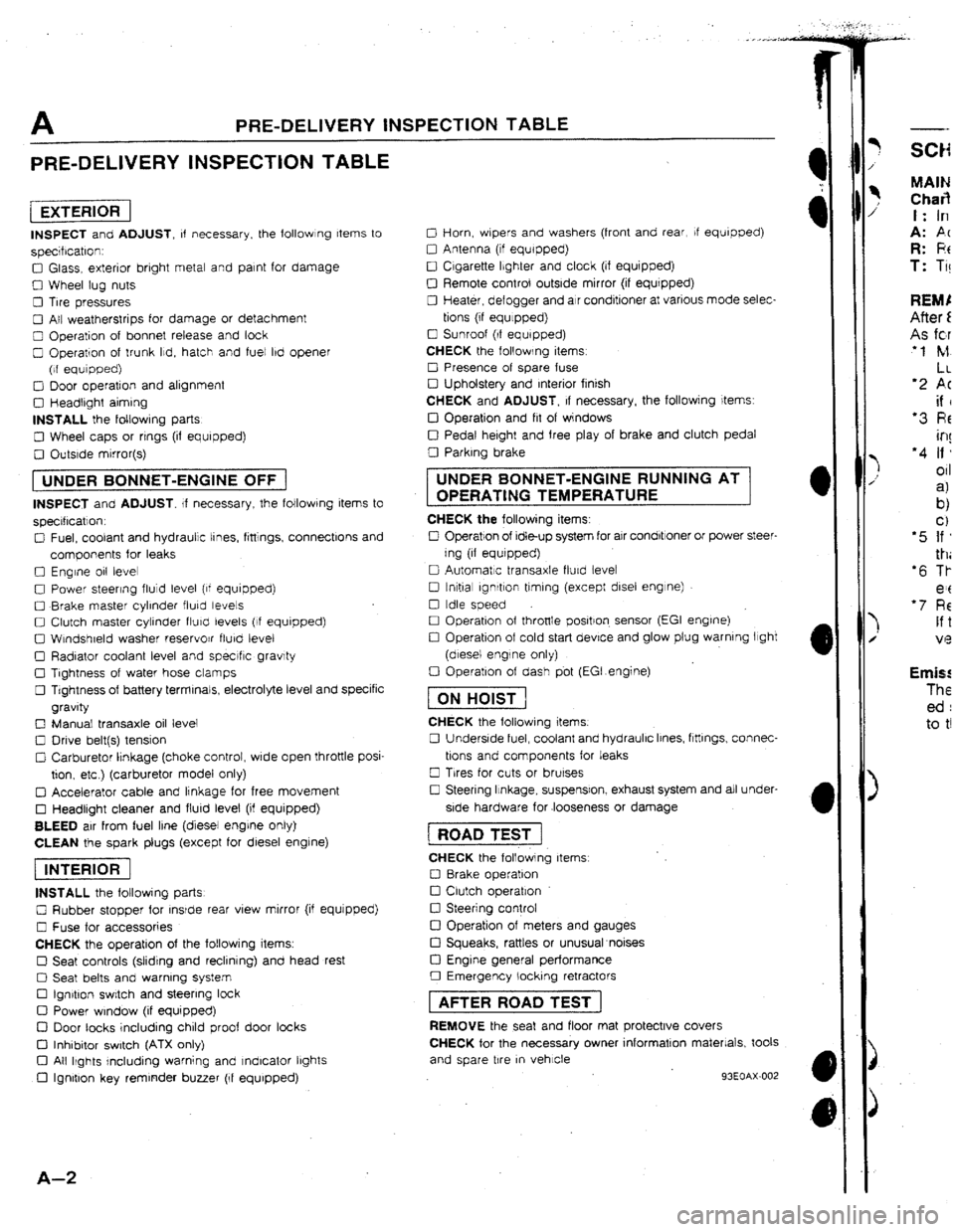
A PRE-DELIVERY INSPECTION TABLE
PRE-DELIVERY INSPECTION TABLE
[EXTERlORI
INSPECT and ADJUST, of necessary. the followlng Items to
specrfrcatron:
0 Glass, exterior bright metal and paint for damage
0 Wheel lug nuts
0 Tire pressures
0 All weatherstrips for damage or detachment
0 Operation of bonnet release and look
0 Operation of trunk Ild, hatch and fuel lbd opener
(of equipped)
0 Door operation and alignment
0 Headtrght aiming
INSTALL the foltowrng parts
0 Wheel caps or rrngs (if equipped)
0 Outsrde mirror(s)
1 UNDER BONNET-ENGINE OFF j
INSPECT and ADJUST. If necessary, the following items to
specrflcatlon.
0 Fuel, coolant and hydraulic tines, fittings, connectlons and
components for leaks
0 Engine 011 level
0 Power steering fluid level (of equipped)
0 Brake master cylinder fluky levels
0 Clutch master cylinder fturcl levels (If equipped)
0 Wtndshreld washer reservojr flurd level
0 Radiator coolant level and specrfic gravity
0 Tightness of water hose clamps
0 Tightness of battery terminals, electrolyte level and specific
gravity
0 Manual transaxle oil level
0 Drive belt(s) tension
Cl Carburetor lrnkage (choke control, wrde open throttle posi-
tion. etc ) (carburetor model only)
q Accelerator cable and linkage for free movement
0 Headlight cleaner and flurd level (if equipped)
BLEED air from fuel line (diesel engrne only)
CLEAN the spark plugs (except for diesel engine)
piEi6F]
INSTALL the following parts
0 Rubber stopper for rnsrde rear view mirror (if equjpped)
0 Fuse for accessories
CHECK the operation of the following items.
0 Seat controls (sliding and reclining) and head rest
0 Seat belts and warning system
Cl Ign&on switch and steering lock
0 Power window (if equipped)
D Door tacks including child proof door locks
Cl Inhibitor switch (ATX only)
Cl All Ikghts rncluding warning and Indicator lbghts
0 Ignition key reminder buzzer (If equipped)
A-Z
0 Horn, wbpers and washers (front and rear, If equipped)
0 Antenna (tf equipped)
0 Cigarette Ibghter and clock (if equipped)
0 Remote control outside mirror (if equrpped)
0 Heater, defogger and air conditioner at various mode selec-
tions (if equlppedj
0 Sunroof (If equipped)
CHECK the following items
0 Presence of spare fuse
0 Upholstery and Interior finish
CHECK and ADJUST, If necessary, the followjng items:
IJ Operation and fit of windows
0 Pedal height and free play of brake and clutch pedal
0 Parking brake UNDER BONNET-ENGINE RUNNING AT
OPERATING TEMPERATURE
CHECK the following items:
0 Operation of Idle-up system for air condbtroner or power steer-
ing (if equrpped)
0 Automatic transaxle flurd levet
0 tnltial ignrtlon timing (except disel engine)
0 Idle speed
0 Operation of throttle positron. sensor (EGI engrne)
0 Operation of cold start device and glow plug warning light
(diesel engine only)
0 Operation of dash pbt (EGI.engine)
fTiGGJ
CHECK the following items.
0 Underside fuel, coolant and hydraulic Irnes, ftttlngs, connec-
tions and components for leaks
0 Trres for cuts or brurses
0 Steering Itnkage, suspensron, exhaust system and all under-
side hardware for .looseness or damage 1 ROAD TEST j
CHECK the following items
0 8rake operation
0 Clutch operation
0 Steering control
!ZI Operation of meters and gauges
Cl Squeaks, rattles or unusual noises
Cl Engine general performance
0 Emergency locking retractors 1 AFTER ROAD TEST ]
REMOVE the seat and floor mat protective covers
CHECK for the necessary owner information materials, took
and spare tire
m vehicle
93EOAX-002
-- MAIN Char3 t: In
A: PC R: F!t T: Ti! Emis! The ed : to t!
Page 26 of 279
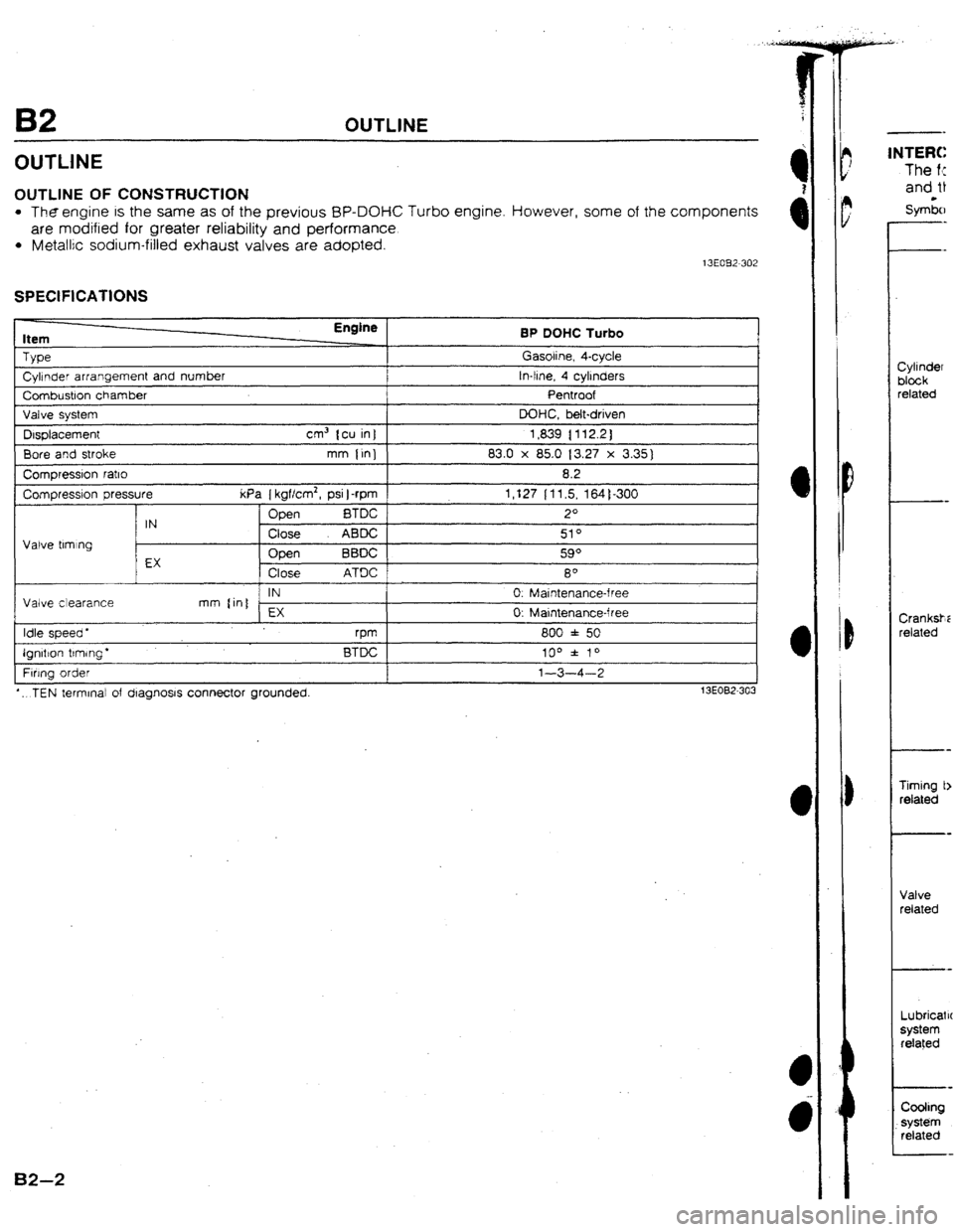
B2 OUTLINE
OUTLINE
OUTLINE OF CONSTRUCTION
l Theengine is the same as of the previous BP-DOHC Turbo engine. However, some of the components
are modified for greater reliability and performance.
l Metallic sodium-filled exhaust valves are adopted. 13E032-302
SPECtFlCATIONS
Item
TYPe
Cyhnder arrangement and number
Combustion chamber
Valve system
Displacement cm3 tcu in]
Bore and stroke mm {in)
Compressron ratio
Compressron pressure kPa [ kgf/cm2, psi 1
-rpm
Open
BTDC
IN
Close ABDC
Valve tlmlng
EX Open BBDC
Close ATDC
IN
Valve clearance mm (in]
EX
Idle speed *
rpm
Ignltlon trmrng’ BTDC
Fwng order
*.. TEN terminal of dragnosrs connector grounded. Gasoline, 4-cycle
tn-line, 4 cyljnders
Pentroof
DOHC, belt-driven
1,839 { 112.2)
83.0 x 85.0 13.27 x 3.35)
8.2
1,127 lt1.5, 164)-300
2O
510
590
8O
0. Maintenance-free
0: Maintenance-free
800 f 50
100 f 70
l-3-4-2
13EOB2-303
82-2
1NTERC
The f<
and 0
S ym&l
-
Cytinder
block
related
Crank&;
related
Timing b
related
Vatve
related
Lubricatrc
system related
Coohng
. . system
related
Page 27 of 279

The following chart shows interchangeability of the main parts of the previous BP DOHC Turbo engine
and the new BP DOHC Turbo engine for 4WD models.
S ymiols: 0 _. lnterc hangeable X . . . Not Interchangeable
Part name tnterchangeability
Remark
Cytlnder head 0
Camshaft 011 seal 0
Cvllnder head bolt 0
CB :
Cyh nder
blcck
related
Crankshaft
related
Timing belt
related
Valve
related
Lubrication
system
related Cylrnder head gasket 0
Wnder head cover 0
Cylinder head cover gasket
Cylinder block
MaEn bearina cao 0
0
0
Ma+n bearino suo~oFt elate I
0 I ” ,I I
Oil pan
Timrno belt cover I X
0 I
Turbocharger oil return pipe hole increased from
13mm IO.51 in) to 17mm IO.67 in)
Seal elate
Front orl seal I 0 I
I I 0
1
Rear 011 seal 0
Crankshaft 0
Marn bearina 0
Thrust bearing
Connectmg rod
Connecting rod beartng
Piston 0
;J
X
Shape different
Piston skirt shortened
I Piston pm cl
Tw
X Sectional shape different
Piston rrng Piston ring end gap increased from 0:?5--0.30mm
Second
X ~0.006-0.011 in ) to 0.35-0.50mm IO.01 4-0.019
in ] (Measured In cylinder)
Crankshaft pulley Shape different
Rear cover ;5
Flywheel
I 0
Flywheel bolt 0
Tbmlng belt 0
Timing belt crank pulley 0
Camshaft pulley 0
Timing belt tensioner and spring
0
Idler 0
Camshaft 0
AA
Valve Intake
Exhaust
cl
0
X Metallic sodium-filled valve
Valve spring Intake
I 0
and seat
Exhaust 0
Vatve wide I 0
Valve seal
Oil pump 0
Oil pump gasket 0
oil strainer 0
Oil strainer gasket 0
Oil cooler
X Heat dissi patlon capacity increased
Oil jet
Oil filter Shape different
1 Water pump 0
Coohng Thermostat 0
system
related Radiator 0
Cooling fan 0
I 3EO32.304
BZ-3.
Page 47 of 279

F3 CONTROL SYSTEM
PRESSURE REGULATOR CONTROL SYSTEM
SOLENOID VALVE TO MAIN RELAY
(PRC HIGH TEYP.)
t ECU
I
PRESSURE REGULATOR
// VACUUM
IJ WATER
THERMOSENSOR
F----------- lNTAKE AIR
THERMOSENSOR
SWITCH SOLEltolD VALVE
(PRC LOW TEMP.)
TO FUEL TANK
13EOF3-31 To prevent vaporlock in the fuel system during hot restart idle, a two-stage pressure regulator is adoped
to the new 323 4WD.
Low temperature operation: The vacuum to the pressure regulator (A and B ports) is cut (solenoid valve
[low temp.] UN), and the fuel injection pressure is increased to 284 kPa (2.90 kgf/cm2, 41 psi ) ,
High temperature operation: The vacuum to the pressure regulator (A port) is cut (solenoid valve [high
temp.] ON), and the fuel injection pressure is increased to 343 kPa [ 3.5 kgf/cm2, 49 psi 1.
Condition and operation
Condition Operation
1
coolant Intake alt Solenoid vrlve Solenoid vatve Opemtlon
I temperature temperature Engine (Idw temp.)
(high temp.) time Operation 40% [fU40f)-
Above 90°C 5U°C (t22OFI ON OFF 180s Low temp.
f f940Fj No load
Above 5O*C
I122OF) OFF ON 210s t-ltgh temp.
3
t3EOF3-319
F3-14 Wast
l Ins fuel
l In:; InJeci
l In:;
l Vol Injecl
l In:;
Presr
l SCI Engir
l InsI
Page 58 of 279

TROUBLESHOOTING GUIDE F3
4 CRANKS NORMALLY 8UT WILL NOT START (PARTfAL COMBUSTION) - AFTER WARM-UP
&RIP-
l Engine cranks at nurmal speed and shows partial combustion but will not Continue running after being hot
soaked
FION
l Battery in normal condltlon
*Engine starts normally when cold
TROUBLESHOOTING
HINTS] 3 Air/Fuel mixture too rich @ Vaporlock
ssure not held in fuel line after engrne IS
GND mth jumper wire tor 3
minutes with ignition
Fuel
line pressure: 265-314 kPs (2.7-3.2 kgflcm2, 38-46 psi 1
c3 If pressure
quickly increases,
check pressure regulator
4 If pressure
gradually increases,
check fuel line and filter lor
clogging
If hose is not clogged. check fuel
pump maximum pressure
High pressure Check if fuel return hose is clogged or
restricted
INSTALL CLAMPS e If rt is not, replace pressure
regulator
@ It It 6. repalr or replace it CT page F3-3
F3-25
Page 60 of 279

TROUBLESHOOTING GUlDE F3
7 CRANKS NORMALLY BUT HARD TO START - AFTER WARM-UP
*
l Engrne cranks at normal speed but requkres excessive cranking time before starting after running and being
DESCRIP- hot soaked
TION
l Battery rn normal condition l Engine starts normatly when cold
*Engine runs normally at Idle (If idle condrtron is not OK, refer to “Rough idle” ~Nos. 8-l 21)
[ ~ROUBLESHOOTLNG HINTS1
[ i 5 ArrlFuel mixture too Rich - l Fuel rqection control malfunction l lnpector fuet leakage
I
TEP tNSPECTlON @ Vaporlock
l Fuel pressure not held rn fuel line after engrne IS
stopped
l Pressure regulator control system malfunction
I ACTION
1 Is “00” dispiayed on Self-Diagnoses
Checker wrth rgnrtron switch ON7
SYSTEM?_SELECT. 1
SELECT SW. A
Remove vacuum hose from pressure regulator
(port A) ancI plug rt. dOt?S engine start normally’-,
Remove both vacuum hoses from pressure regu-
lator (ports A and Bj and plug them; does en-
gine start normally7
@
PtUG
/ /
Are ECU terminal voltages OK
(especially 1 C, 20, 20 and 2T)?
w page F3-46 Yes Go to next step
No Service Code No. displayed
Check for cause (Refer to specified
check sequence) CT oaae F3-16
“88” flashes
Check ECU terminal 1F voltage
Voltage: Battery voltage
(ignition switch ON) w page F3-45
( cs> It OK. replace ECU
/ w page F3-2’
3 If not OK, check wlrtng
(ECU - Self-Dlagnosrs ChecKer)
Yes Check pressure regulator control sys-
.
tern (high temperature operation) w page F3-43
I NO Go to next step
Check pressure regulator control sys-
tem (low temperature operation)
No 1 Go to next step
Yes Go to next step
NO Check for cause
F3-27